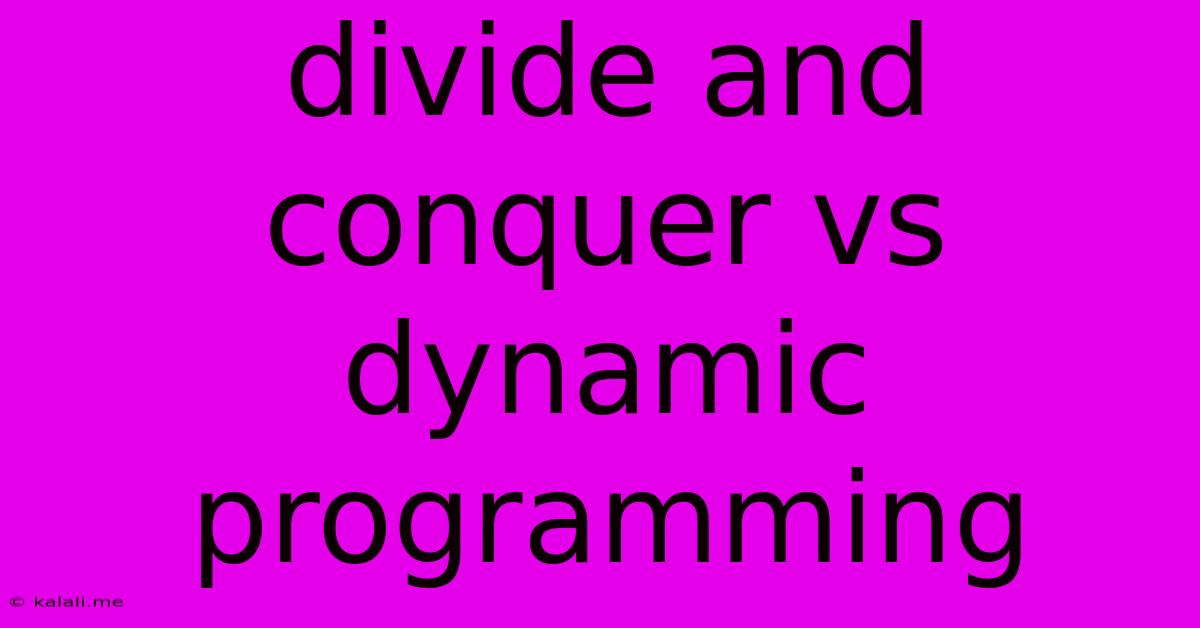Divide And Conquer Vs Dynamic Programming
Kalali
Jun 13, 2025 · 3 min read

Table of Contents
Divide and Conquer vs. Dynamic Programming: Two Powerful Algorithm Design Paradigms
Meta Description: Understand the key differences between Divide and Conquer and Dynamic Programming, two powerful algorithm design techniques used to solve complex problems efficiently. Learn when to apply each approach for optimal results.
Divide and Conquer and Dynamic Programming are two fundamental algorithmic design paradigms used to solve complex problems efficiently. While both aim to break down a problem into smaller, more manageable subproblems, they differ significantly in their approach and applicability. Understanding these differences is crucial for choosing the right technique for a given problem. This article will delve into the nuances of each paradigm, highlighting their strengths, weaknesses, and when to employ them.
Divide and Conquer: The Art of Subproblem Decomposition
Divide and Conquer algorithms work by recursively breaking down a problem into smaller, independent subproblems of the same type. These subproblems are solved independently, and their solutions are then combined to produce the solution to the original problem. This recursive decomposition continues until the subproblems become trivial to solve.
Key Characteristics of Divide and Conquer:
- Independent Subproblems: The subproblems are solved independently, without influencing each other. This allows for efficient parallel computation.
- Recursive Approach: The algorithm recursively breaks down the problem until it reaches a base case.
- Combination of Solutions: The solutions to the subproblems are combined to produce the overall solution.
Examples of Divide and Conquer Algorithms:
- Merge Sort: Recursively divides an unsorted list into smaller sublists until each sublist contains only one element, then merges the sublists to produce a sorted list.
- Quick Sort: Selects a 'pivot' element and partitions the array around the pivot, recursively sorting the sub-arrays.
- Binary Search: Efficiently searches for a target value in a sorted array by repeatedly dividing the search interval in half.
Dynamic Programming: Optimizing Overlapping Subproblems
Dynamic Programming tackles problems with overlapping subproblems—subproblems that are repeatedly solved during the recursive process. Instead of repeatedly solving these subproblems, dynamic programming stores the solutions to these subproblems and reuses them when needed. This avoids redundant computations, significantly improving efficiency.
Key Characteristics of Dynamic Programming:
- Overlapping Subproblems: The problem exhibits repeated computation of the same subproblems.
- Optimal Substructure: The optimal solution to the problem can be constructed from the optimal solutions to its subproblems.
- Memoization or Tabulation: Solutions to subproblems are stored (either through memoization—top-down—or tabulation—bottom-up) to avoid redundant computations.
Examples of Dynamic Programming Algorithms:
- Fibonacci Sequence: Calculates the nth Fibonacci number efficiently by storing previously computed values.
- Longest Common Subsequence: Finds the longest subsequence common to two sequences by building a table of optimal solutions to subproblems.
- Knapsack Problem: Determines the most valuable combination of items that can be carried in a knapsack with a weight limit.
Divide and Conquer vs. Dynamic Programming: A Comparison Table
| Feature | Divide and Conquer | Dynamic Programming |
|---|---|---|
| Subproblems | Independent | Overlapping |
| Approach | Recursive | Iterative (tabulation) or Recursive (memoization) |
| Redundancy | No significant redundancy | Significant redundancy if not optimized |
| Efficiency | Highly efficient for independent subproblems | More efficient for problems with overlapping subproblems |
| Applicability | Problems with independent subproblems | Problems with overlapping subproblems and optimal substructure |
When to Use Which Technique?
The choice between Divide and Conquer and Dynamic Programming depends heavily on the nature of the problem:
-
Use Divide and Conquer when: The problem can be broken down into independent subproblems that can be solved recursively without significant overlapping computations. Efficiency comes from the parallelizability of independent subproblems.
-
Use Dynamic Programming when: The problem exhibits overlapping subproblems and possesses an optimal substructure. Efficiency gains are achieved by storing and reusing solutions to common subproblems, avoiding redundant calculations.
In essence, both Divide and Conquer and Dynamic Programming are powerful tools in an algorithm designer's arsenal. Understanding their strengths and weaknesses enables effective problem-solving and the development of efficient and elegant algorithms. Choosing the appropriate technique depends on the specific characteristics of the problem at hand.
Latest Posts
Latest Posts
-
Molecules Of Life Include Which One Of The Following
Jun 14, 2025
-
Lowest Common Multiple Of 10 And 35
Jun 14, 2025
-
How Many Valence Electrons Does Astatine Have
Jun 14, 2025
-
The Atomic Mass Of An Element Is Equal To The
Jun 14, 2025
-
What Is The Opposite Of Domestic
Jun 14, 2025
Related Post
Thank you for visiting our website which covers about Divide And Conquer Vs Dynamic Programming . We hope the information provided has been useful to you. Feel free to contact us if you have any questions or need further assistance. See you next time and don't miss to bookmark.